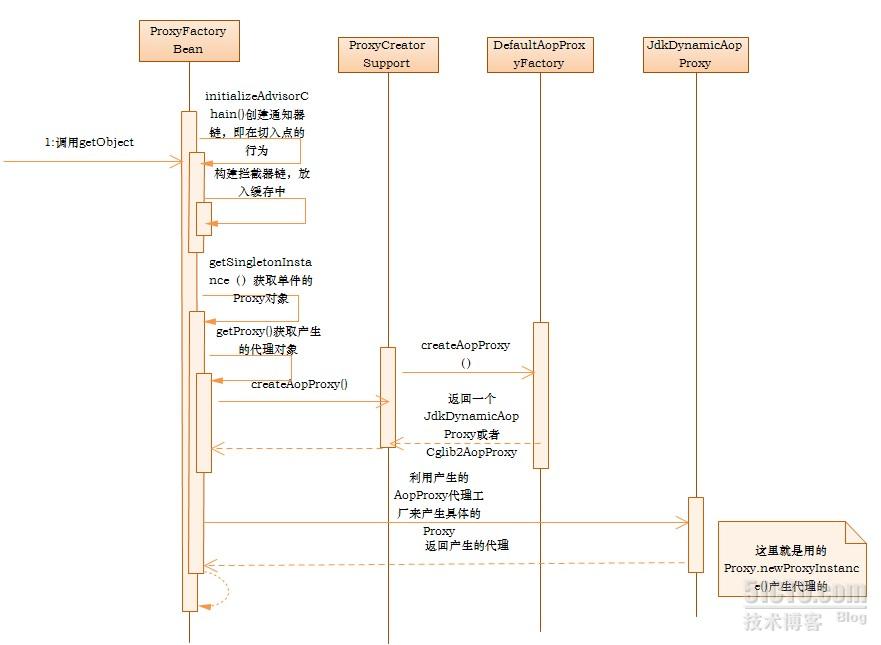基于Spring源码分析AOP的实现机制
2013-07-18 08:29
936 查看
Spring一个重要的特性就是提供了AOP,使得我们可以在原有的基础上增加我们自己的系统业务逻辑。使得我们系统业务逻辑与应用业务逻辑相分离,耦合性降低,并且大大的提高了开发的效率。Spring的AOP利用的就是动态代理方式,在Spring的AOP中,有两种实现方式。第一种,就是利用JDK的Proxy,另外一种就是采用CGLIB来实现的。
基本概念:
Advice:
通知,制定在连接点做什么,在Sping 中,他主要描述Spring 围绕方法调用注入的额外的行为,具有增强的功能 ,只能应用于所有方法,主要是由aopalliance.jar中包含aop定义中的接口,按这个接口实现aop标准。
PointCut
切点,其决定一个 advice 应该应用于哪个连接点,也就是需要插入额外处理的地方的集合,例如,被某个advice 作为目标的一组方法。Spring pointcut 通常意味着标示方法,可以选择一组方法调用作为pointcut。
Advisor:
通知器,把Advice封闭起来,加入Pointcut(切入点),Spring就可以知道在什么方法上拦截,以及拦截后所要做的具体行为了。Advisor有两种实现NameMatchMethodPointcutAdvisor按方法名字匹配。RegexpMethodPointcutAdvisor,按正则匹配。
AOP创建:
AOP的创建主要分为两种一种是JDK的Proxy还有一种是CGLIB的,整个创建AOP的时序图一样,只不过差异在于最终AOPProxy产生AOP的过程。
首先AOP的具体创建的时序图如下:

以该时序图来分析我们AOP的创建过程。当我们使用AOP需要对某一个对象进行切面系统业务的时候,Spring会为该对象生成一个代理。具体是使用ProxyFactoryBean来配置我们的代理对象和方面行为。而具体的代理实现是通过JDK的Proxy或者CGLIB来完成的。ProxyFactoryBean是FactoryBean,调用该getObject方法:
第一行主要就是初始化通知器链,注册被代理对象上的拦截器。
当判断是一个单例对象的时候,就会通过getSingletonInstance()来获取单件
ClassUtils.isPresent("net.sf.cglib.proxy.Enhancer", DefaultAopProxyFactory.class.getClassLoader());是否当前路径有cglib2
AOP拦截器
当使用JDK和CGLIB会生成不同的AopProxy代理对象,从而构造了不同的回调方法来启动对拦截器链的调用,比如在JdkDynamicAopProxy中的invoke方法,以及Cglib2AopProxy中使用DynamicAdvisedInterceptor的intercept方法。它们都使用了不同的AopProxy代理对象,但最终对AOP拦截的处理都是基本一样:它们对拦截器链的调用都是在ReflectiveMethodInvocation中通过proceed方法实现的。在这个proceed方法里,会逐个运行拦截器的拦截方法。在运行拦截器的拦截方法之前,需要对代理方法完成一个匹配判断,通过这个匹配判断来决定拦截器是否满足切面增强的要求。
AOP拦截器的实现的时序图如下:

对目标的对象都会首先被代理至代理对象的invoke来调用,不管使用哪种创建代理对象的过程
下面是invoke的方法:
对目标对象的方法直接调用是利用AopUtils.invokeJoinpointUsingReflection,该方法内部直接调用method.invoke(target, args),利用jdk自身的反射机制实现的;对拦截器链的调用时由ReflectiveMethodInvocation的proceed方法来实现的。
在proceed方法中,依然会首先判断是否拦截器结束了,否则就从拦截器链获取一个个的拦截器来执行前置行为,最后调用完了才真正调用我们的目标方法。
本文出自 “在云端的追梦” 博客,请务必保留此出处http://computerdragon.blog.51cto.com/6235984/1251718
基本概念:
Advice:
通知,制定在连接点做什么,在Sping 中,他主要描述Spring 围绕方法调用注入的额外的行为,具有增强的功能 ,只能应用于所有方法,主要是由aopalliance.jar中包含aop定义中的接口,按这个接口实现aop标准。
PointCut
切点,其决定一个 advice 应该应用于哪个连接点,也就是需要插入额外处理的地方的集合,例如,被某个advice 作为目标的一组方法。Spring pointcut 通常意味着标示方法,可以选择一组方法调用作为pointcut。
Advisor:
通知器,把Advice封闭起来,加入Pointcut(切入点),Spring就可以知道在什么方法上拦截,以及拦截后所要做的具体行为了。Advisor有两种实现NameMatchMethodPointcutAdvisor按方法名字匹配。RegexpMethodPointcutAdvisor,按正则匹配。
AOP创建:
AOP的创建主要分为两种一种是JDK的Proxy还有一种是CGLIB的,整个创建AOP的时序图一样,只不过差异在于最终AOPProxy产生AOP的过程。
首先AOP的具体创建的时序图如下:

以该时序图来分析我们AOP的创建过程。当我们使用AOP需要对某一个对象进行切面系统业务的时候,Spring会为该对象生成一个代理。具体是使用ProxyFactoryBean来配置我们的代理对象和方面行为。而具体的代理实现是通过JDK的Proxy或者CGLIB来完成的。ProxyFactoryBean是FactoryBean,调用该getObject方法:
public Object getObject() throws BeansException {
//初始化通知器链,实际上就是注册拦截器
initializeAdvisorChain();
if (isSingleton()) {
//返回生成的一个单件Proxy
return getSingletonInstance();
}
else {
....
//返回生成的Prototype的Proxy
return newPrototypeInstance();
}
} 整个方法包含了拦截器的初始化,以及获取代理对象的代理的过程。第一行主要就是初始化通知器链,注册被代理对象上的拦截器。
当判断是一个单例对象的时候,就会通过getSingletonInstance()来获取单件
private synchronized Object getSingletonInstance()
{
if (this.singletonInstance == null)
{
this.targetSource = freshTargetSource();
if (this.autodetectInterfaces && getProxiedInterfaces().length == 0 && !isProxyTargetClass())
{
//获取要代理的类
Class targetClass = getTargetClass();
...设置该类的接口类型
setInterfaces(ClassUtils.getAllInterfacesForClass(targetClass, this.proxyClassLoader));
}
super.setFrozen(this.freezeProxy);
//这里才是真正的获取Proxy,
this.singletonInstance = getProxy(createAopProxy());
}
return this.singletonInstance;
} 在获取单件的时候,首先要做的就是要获取目标对象的接口,然后再次创建一个AopProxy来用于创建我们的AOP对象,这里createAopProxy的调用就是调用具体父类ProxyCreatorSupport来完成创建一个DefaultAopProxyFactory。当我们new一个ProxyFactoryBean的时候,它会调用父类的无参构造器,这里面就会默认的创建一个DefaultAopProxyFactory。这个就是我们默认的AOP代理工厂,最终是由它来决定我们到底使用JDK的Proxy还是CGLIB来创建代理的过程。在该类的成员属性中cglibAvailable初始化的时候会监测ClassUtils.isPresent("net.sf.cglib.proxy.Enhancer", DefaultAopProxyFactory.class.getClassLoader());是否当前路径有cglib2
public AopProxy createAopProxy(AdvisedSupport config) throws AopConfigException
{
if (config.isOptimize() || config.isProxyTargetClass() || hasNoUserSuppliedProxyInterfaces(config)) {
Class targetClass = config.getTargetClass();
//代理类为空的时候
if (targetClass == null) {
....
}
// 代理对象为接口的时候
if (targetClass.isInterface()) {
return new JdkDynamicAopProxy(config);
}
if (!cglibAvailable) {
}
eturn CglibProxyFactory.createCglibProxy(config);
}
else {
return new JdkDynamicAopProxy(config);
} 当我们的AopProxy产生后,接着就可以调用getProxy来返回产生的代理对象,这里以JdkDynamicAopProxy为例来分析其创建的过程。public Object getProxy(ClassLoader classLoader) {
if (logger.isDebugEnabled()) {
....}
Class[] proxiedInterfaces = AopProxyUtils.completeProxiedInterfaces(this.advised);
findDefinedEqualsAndHashCodeMethods(proxiedInterfaces);
return Proxy.newProxyInstance(classLoader, proxiedInterfaces, this);
} 当我们的Spring创建了代理对象后,当调用目标对象上的方法时,将都会被代理到InvocationHandler类的invoke方法中执行。在这里JdkDynamicAopProxy类实现了InvocationHandler接 口。AOP拦截器
当使用JDK和CGLIB会生成不同的AopProxy代理对象,从而构造了不同的回调方法来启动对拦截器链的调用,比如在JdkDynamicAopProxy中的invoke方法,以及Cglib2AopProxy中使用DynamicAdvisedInterceptor的intercept方法。它们都使用了不同的AopProxy代理对象,但最终对AOP拦截的处理都是基本一样:它们对拦截器链的调用都是在ReflectiveMethodInvocation中通过proceed方法实现的。在这个proceed方法里,会逐个运行拦截器的拦截方法。在运行拦截器的拦截方法之前,需要对代理方法完成一个匹配判断,通过这个匹配判断来决定拦截器是否满足切面增强的要求。
AOP拦截器的实现的时序图如下:

对目标的对象都会首先被代理至代理对象的invoke来调用,不管使用哪种创建代理对象的过程
下面是invoke的方法:
public Object invoke(Object proxy, Method method, Object[] args) throws Throwable {
MethodInvocation invocation;
Object oldProxy = null;
boolean setProxyContext = false;
TargetSource targetSource = this.advised.targetSource;
Class targetClass = null;
Object target = null;
try {
if (!this.equalsDefined && AopUtils.isEqualsMethod(method)) {
return equals(args[0]);
}
if (!this.hashCodeDefined && AopUtils.isHashCodeMethod(method)) {
return hashCode();
}
if (!this.advised.opaque && method.getDeclaringClass().isInterface() &&
method.getDeclaringClass().isAssignableFrom(Advised.class)) {
// 利用Proxy配置来调用服务,直接调用目标方法
return AopUtils.invokeJoinpointUsingReflection(this.advised, method, args);
}
Object retVal;
if (this.advised.exposeProxy) {
oldProxy = AopContext.setCurrentProxy(proxy);
setProxyContext = true;
}
//获取所要代理的对象
target = targetSource.getTarget();
if (target != null) {
targetClass = target.getClass();
}
// 获得该方法上的拦截器链
List<Object> chain = this.advised.getInterceptorsAndDynamicInterceptionAdvice(method, targetClass);
//是否定义拦截器,否则直接调用目标对象的方法
if (chain.isEmpty()) {
//直接调用目标对象的方法
retVal = AopUtils.invokeJoinpointUsingReflection(target, method, args);
}
else {
//如果不为空,则就创建一个ReflectiveMethodInvocation对象来先调用拦截器后调用目标方法
invocation = new ReflectiveMethodInvocation
(proxy, target, method, args, targetClass, chain);
// 处理切入点上的拦截器的方法
retVal = invocation.proceed();
}
if (retVal != null && retVal == target && method.getReturnType().isInstance(proxy) &&
!RawTargetAccess.class.isAssignableFrom(method.getDeclaringClass())) {
retVal = proxy;
}
return retVal;
}
finally {
if (target != null && !targetSource.isStatic()) {
targetSource.releaseTarget(target);
}
if (setProxyContext) {
AopContext.setCurrentProxy(oldProxy);
}
}对目标对象的方法直接调用是利用AopUtils.invokeJoinpointUsingReflection,该方法内部直接调用method.invoke(target, args),利用jdk自身的反射机制实现的;对拦截器链的调用时由ReflectiveMethodInvocation的proceed方法来实现的。
在proceed方法中,依然会首先判断是否拦截器结束了,否则就从拦截器链获取一个个的拦截器来执行前置行为,最后调用完了才真正调用我们的目标方法。
public Object proceed() throws Throwable {
//直接调用目标方法,可能是拦截器调用结束或者无拦截器
//interceptorsAndDynamicMethodMatchers这个其实就是目标方法上的拦截器链的大小
if (this.currentInterceptorIndex == this.interceptorsAndDynamicMethodMatchers.size() - 1) {
return invokeJoinpoint();
}
//调用拦截器链上的对象,依次
Object interceptorOrInterceptionAdvice =this.interceptorsAndDynamicMethodMatchers.get(++this.currentInterceptorIndex);
if (interceptorOrInterceptionAdvice instanceof InterceptorAndDynamicMethodMatcher)
{
// 这里获得相应的拦截器,如果拦截器可以匹配的上的话,那就调用拦截器的invoke 方法
InterceptorAndDynamicMethodMatcher dm = (InterceptorAndDynamicMethodMatcher) interceptorOrInterceptionAdvice;
if (dm.methodMatcher.matches(this.method, this.targetClass, this.arguments)) {
return dm.interceptor.invoke(this);
}else {
//调用拦截器链中的下一个拦截器
return proceed();
}
}
else {
// It's an interceptor, so we just invoke it: The pointcut will have
// been evaluated statically before this object was constructed.
return ((MethodInterceptor) interceptorOrInterceptionAdvice).invoke(this);
}
}本文出自 “在云端的追梦” 博客,请务必保留此出处http://computerdragon.blog.51cto.com/6235984/1251718
相关文章推荐
- 基于Spring源码分析AOP的实现机制
- Spring实现AOP源码分析
- spring aop源码实现分析
- Spring Aop 源码实现原理分析
- Spring2.5源码解读 之 基于annotation的Controller实现原理分析(1)
- 【Spring实战】----Security4.1.3鉴权之美--基于投票的AccessDecisionManager实现及源码分析
- Spring2.5源码解读 之 基于annotation的Controller实现原理分析(1)
- Spring源码分析----AOP概念(Advice,Pointcut,Advisor)和AOP的设计与实现
- Spring源码分析之ProxyFactoryBean方式实现Aop功能的分析
- Spring AOP的实现机制(三)---@AspectJ形式的Spring AOP和基于Schema的AOP
- Spring源码分析——AOP实现(1)
- Spring源码分析——AOP实现(2)
- spring源码分析,重新认识spring 二(aop实现详细分析)
- spring源码分析之——spring 事务管理实现方式 (不太清晰,不明白aop会看不懂)
- Dubbo源码分析 ---- 基于SPI的扩展实现机制
- Spring 源码分析(三) —— AOP(三)实现思路
- Spring Aop实现机制分析原理
- springmvc工作原理以及源码分析(基于spring3.1.0)
- Spark MLlib LDA 基于GraphX实现原理及源码分析
- 采用双内核机制基于uClinux的实时操作系统分析与实现 form:http://www.eetchina.com
